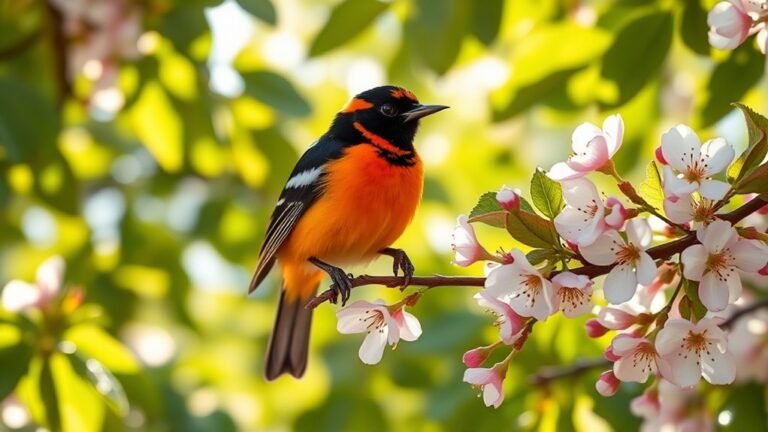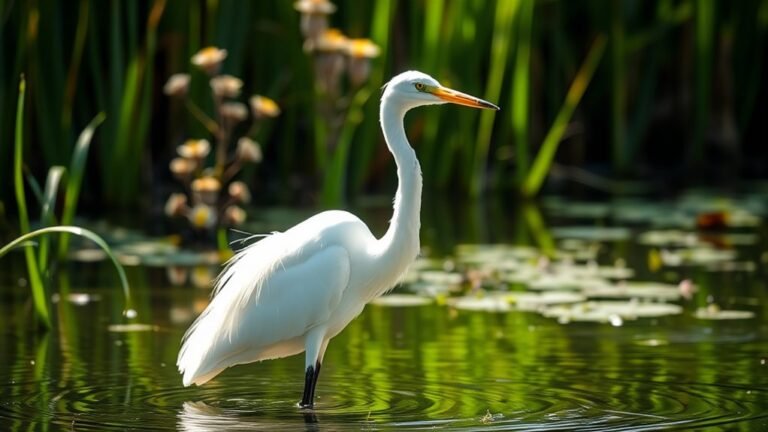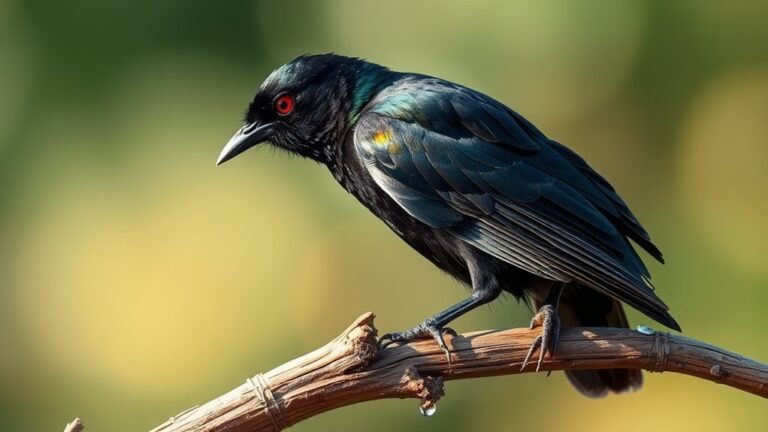What Bird Symbolizes the Start of Spring?
The American Robin is often seen as the bird that represents the start of spring. This bird, easily recognized by its bright red breast and lively song, indicates when winter ends and warmer days begin. The arrival of robins is a clear sign of seasonal change. Other birds also signal the coming of spring, each adding its unique touch to this beautiful transition.
Key Takeaways
The American Robin signifies the start of spring with its arrival and cheerful song.
Barn Swallows also mark the season by migrating back to their nesting spots, where they build nests each year.
Peepers, small frogs, announce spring through their distinctive calls, signaling the end of winter and the warming weather.
Woodcocks perform aerial displays and sounds, indicating their breeding season and the arrival of spring.
The bright yellow feathers of the American Goldfinch bring joy and renewal, making it another symbol of spring.
These animals highlight the beauty and change that spring brings to our environment.
The Robins: Nature's First Messengers of Spring
When you see a robin hopping on your lawn, it signals the start of spring.
Robins have interesting behaviors that show how they adapt to their environment. Their nesting habits are noteworthy; they like to build nests in sheltered areas using mud and grass, which helps them raise their young successfully.
You can often find them searching for worms and insects, a sign of warmer weather and a healthy ecosystem. As robins sing, they establish their territory and create a sense of community.
Watching robins connects you to nature's cycle, reminding you of the renewal of life with each changing season.
The Arrival of the Barn Swallow
As spring brings warmer weather, the barn swallow arrives. This bird travels many miles from winter homes to signal the start of the season. Their return means more insects and a change in the environment.
Here are important details about the barn swallow:
- Nest Building: They create cup-shaped nests from mud and grasses.
- Preferred Locations: They like to build nests in sheltered areas like barns or under bridges.
- Insect Control: They eat many insects, helping to keep local populations in check.
- Social Nature: Barn swallows enjoy being in groups, creating a lively community atmosphere.
Watch for these birds as they play a vital role in restoring spring's ecosystem.
Enjoy their presence and the life they bring to the season.
Peepers and Their Melodic Calls
You can hear the cheerful calls of peepers as they come out after winter. Their sounds signal the start of spring.
Peeper habits, especially their night singing, create a soundscape that matches the melting ice and blooming plants. These small frogs, mainly spring peepers, use their calls to attract mates and mark their territory. Each chorus is a way of communicating and celebrating new life in wetlands.
If you listen closely, you can notice how their singing changes with temperature and other environmental signals. Embracing these sounds helps you connect with the seasons and feel more at home in nature.
The Symbolism of the American Goldfinch
The arrival of spring brings the cheerful sounds of frogs and the lively sight of the American goldfinch among new leaves.
This bird symbolizes renewal, joy, and community. Observing goldfinches, you'll see them interacting socially. They often feed together and chirp happily.
Their symbolism includes:
- Joy – Their bright yellow feathers represent happiness.
- Renewal – They signify new beginnings, similar to spring.
- Adaptability – Goldfinches thrive in various habitats.
- Community – They show the importance of togetherness.
Understanding these points enhances your appreciation for their role in nature and connects you to the spirit of spring.
Woodcocks: The Dance of Spring
During spring, woodcocks perform a captivating aerial dance.
Male woodcocks showcase their agility through a series of spiraling flight moves. These flights highlight their vibrant feathers.
At dusk, you may see them soaring high and calling with a distinct "peent" sound that fills the air. This behavior attracts females and marks their arrival during spring migration.
Observing woodcock courtship helps you connect with nature. Their displays signal the renewal of the season.
Enjoy watching them under the twilight sky as they illustrate the beauty of spring.
Sparrows and Their Cheerful Presence
As spring arrives, sparrows become lively symbols of the season. Their cheerful chirps and quick movements bring life to gardens and parks.
These birds adapt to various environments and display unique behaviors. Here are some key points:
- Sparrows sing to attract mates and claim territory.
- They thrive in urban areas, fields, and forests, showing their adaptability.
- Sparrows are social birds. They often flock together, creating connections among birdwatchers and nature enthusiasts.
- Their foraging helps control insect populations, supporting the ecosystem's balance.
With their vibrant presence and engaging behaviors, sparrows enrich our natural surroundings.
The Cultural Significance of Spring Migrants
Spring brings joy for many people. The arrival of migratory birds marks a change in seasons and highlights cultural traditions.
These birds influence local customs and rituals. Communities look forward to their return and often celebrate with festivals. For example, the swallows' arrival is important in many areas, symbolizing rebirth and renewal.
This shared experience helps people feel connected to nature and their culture. By learning about bird migrations, you can appreciate the beauty of nature and the stories that spring birds tell each year.
Creating a Bird-Friendly Spring Garden
Creating a bird-friendly garden enriches your outdoor area and supports birds during their spring migration.
To make your garden inviting, consider these key aspects:
- Select native plants: Native plants attract local insects, which serve as important food for birds.
- Use bird feeders: Different types of feeders provide seeds, suet, and nectar for a variety of bird species.
- Add water sources: Birdbaths or shallow dishes supply drinking and bathing water for birds.
- Include cover: Dense shrubs and trees offer safe nesting and shelter for birds.
By incorporating these elements, you build a lively garden that birds will appreciate.
Enjoy watching them thrive in your space!
Frequently Asked Questions
Why Do Robins Return Earlier Than Other Birds in Spring?
Robins come back earlier in spring because they have unique habits and can adapt well. They search for food in the thawed ground and use what is available. This ability helps them thrive while other birds stay inactive, leading to their noticeable early arrival. This behavior highlights their resourcefulness and resilience in changing conditions.
What Factors Influence the Timing of Bird Migrations?
Bird migrations are influenced by several key factors. Temperature changes signal birds to migrate. Longer daylight hours also play a role. Additionally, the availability of food and suitable nesting sites is crucial. These elements together determine when birds start their migratory journeys each year.
How Can I Identify Different Species of Spring Birds?
To identify different species of spring birds, focus on their unique features. Pay attention to their size, color patterns, and beak shapes. Observing these characteristics will improve your birdwatching skills and increase your enjoyment of the experience. Take notes or use a field guide to help recognize different species you encounter. Enjoy your time watching and learning about birds!
What Are the Best Bird Feeders for Attracting Spring Birds?
To attract spring birds, use tube feeders for smaller birds, platform feeders for those that prefer feeding on the ground, and suet feeders for high-energy food. Offering a variety of bird food will help you attract different species during spring. Enjoy watching the birds visit your feeders and appreciate their diverse behaviors and colors.
How Do Climate Changes Affect Spring Bird Populations?
Climate change affects spring bird populations by changing their migration patterns. Birds now adjust when and where they migrate. This adjustment can impact their breeding success and reduce the variety of birds in local areas. You may notice these changes in the timing of bird arrivals and the types of species that visit your area each spring.

Kashvi is a passionate bird enthusiast and nature lover who has been fascinated by the world of birds for years. With a keen eye for detail and a love for learning, Kashvi is dedicated to sharing her knowledge and insights with fellow bird enthusiasts on Avian Enthusiasts. Through her engaging and informative articles, Kashvi aims to inspire others to join her in exploring the fascinating world of birds and to promote a deeper appreciation for these incredible creatures.






